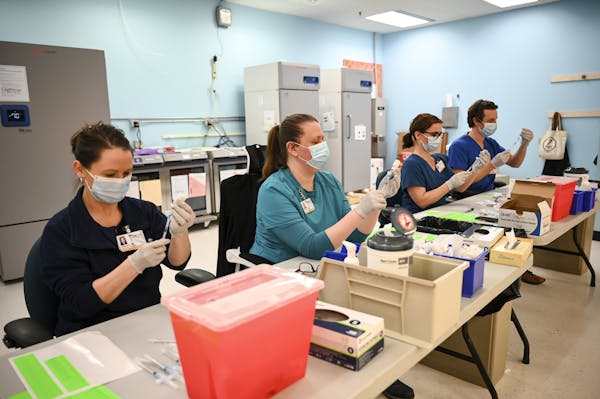The 2021 growing season is about to start in Minnesota, bringing fresh questions about how the state's sizable agriculture and food-processing industries will manage another pandemic spring.
Yet favorable weather and commodity prices last year drove an overall 45% increase in the net value of 13 major Minnesota crops, like soybeans and corn for grain, to $11.7 billion, federal data show. Declines in hog slaughter in April and May didn't stop the state's pork plants from processing 12 million animals throughout 2020, up 1% from the previous year.
Today, Minnesota has just as many live hogs and pigs as it did at this time last year — 9 million.
State officials are now gathering with labor leaders, industry groups and public health agencies to cast a light on the people who work in the industry who will need vaccines, testing and public health information.
It's a wide-ranging goal for the 15 members of Gov. Tim Walz's new Committee on Safety, Health and Wellbeing of Agricultural and Food Processing Workers. The committee includes state officials in health, labor, agriculture and economic development, along with industry, unions and cultural outreach groups and county public health officials.
Members of the committee, who have not yet held their inaugural meeting, said in interviews last week that it's long past time for a formal group to address the needs of agricultural workers and meat-processing plant employees.
Agriculture and food processing "is such a cornerstone to Minnesota's economy, and it doesn't work without people being here to … put in the hard work. And we need to protect them and keep them safe while they are doing it," Minnesota Deputy Agriculture Commissioner and committee co-chairwoman Andrea Vaubel said. "It should have happened sooner, but I'm happy it's here."
Vulnerable workers
Minnesota's 33 meatpacking plants employ about 12,000 people, with a 40% turnover rate in a "highly mobile" workforce, leaving many without an understanding of their legal rights, Walz said in his order creating the committee.
Language is a barrier. The workforces at meatpacking and other agricultural processing plants are largely composed of immigrants from many places, Walz's order said, while on farms 77% of workers say Spanish is their preferred language.
That means the complicated and ever-changing messages about where and when to get tested, how to get vaccinated, and what to do after an exposure must be communicated across multiple languages.
"The people who are harder to reach are particularly those who are not fluent in English and are making temporary arrangements for living," said Rodolfo Gutierrez, an agriculture workforce committee member and executive director of St. Paul-based Latino research and advocacy group Hacer.
It's difficult to know how many workers come to Minnesota for the growing season, but Gutierrez said the number is in the low tens of thousands, including those with visas or permanent legal status as well as migrants here illegally.
He shared a story of going out to survey workers in southern Minnesota for Hacer and discovering a trailer in a mobile home park packed with 20 people sharing the living space, which was mainly used for sleeping since the occupants worked all day.
"They don't receive [public health] information," Gutierrez said. "Or most of the information might be in English, and they can't really use it."
On Friday, Lt. Gov. Peggy Flanagan toured a temporary vaccination site in Worthington, where a JBS USA pork-processing plant shut down for two weeks last April and May amid a fast-moving COVID outbreak among hundreds of its 2,000 workers.
The pop-up vaccination site, which administered 1,000 vaccine doses last week, was organized in partnership with Washington-based Latino advocacy group Unidos. A key question facing the agriculture committee is whether to call for more such vaccine sites this year.
Gutierrez said he'll advocate that the sites use the Johnson & Johnson vaccine, as the one last week in Worthington did, because it requires only a single clinic visit. Workers who have already been vaccinated should bring the vaccine cards they were given, he said.
Latest COVID trends
As of Sunday, more than 976,000 Minnesotans have completed their vaccination, whether it required one dose or two doses. That's 27% of the state's target to vaccinate most people over 16.
Hispanic Minnesotans appear to lag behind other groups in getting vaccinated. According to data that includes most Minnesota vaccinations, less than 6% of the Hispanic population and more than 18% of the white population are fully vaccinated.
Meanwhile, the number of newly diagnosed cases of COVID-19 in Minnesota continues to edge upward. The seven-day average number of new cases per day surpassed 1,400 on Sunday, five weeks after dipping below 800.
The state reported a net increase of 1,225 new cases of COVID on Sunday, bringing Minnesota's total to 515,058.
The Minnesota Department of Health reported an additional five deaths from complications of the viral respiratory illness Sunday. Those who died were ages 55 to 94, and two of them lived in assisted living or long-term care.
No one can say how long the pandemic will last, but Minnesota Farm Bureau President Kevin Papp said he's preparing for it to be ongoing in early May, when southern Minnesota farmers aim to be done planting corn.
While the pandemic brought disruption and uncertainty last spring, it also drove a newfound effort for people across the industry to communicate, including those in agriculture, public health, economic development, private industry and labor.
"It took a disruption for us to say, we have got to have better communication, we have to have better understanding of each other," Papp said. Without the communication, "it could have been a whole lot worse."
Joe Carlson • 612-673-4779

Fall or spring, it's Rochester Mayo's year in prep tennis

Minneapolis reaches $150k settlement with eyewitness of George Floyd's murder

Israel-Hamas war creates 'really fraught times' at Minn. colleges

Rare and fatal brain disease in two deer hunters heightens concerns about CWD

